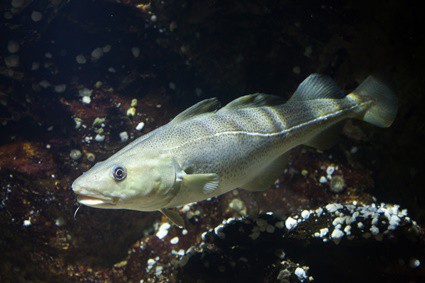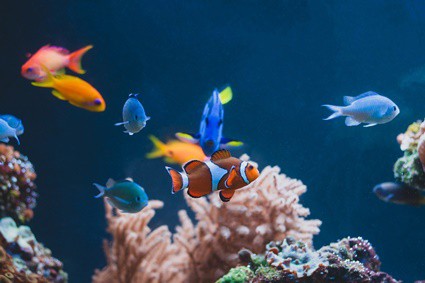Last Updated on: 5th November 2023, 02:39 pm
Fish spend most of their time swimming, so they must do so efficiently to survive. They have a series of muscles, organs, and body parts that allow them to move effortlessly through the water.
Fish have several organs they use to swim underwater.
These include the swim bladder, lateral line, gills, and scales. They also have five prominent fins that stabilize them and enable them to turn, move forwards and backward, and stop.
These fins include the pectoral, pelvic, dorsal, anal, and caudal. To swim, fish contract the muscles on the left-hand side of their body while relaxing the muscles on the right.
They repeat this on the other side. Along with a flexible backbone, this motion propels fish forward.
Fish swim to evade predators, search for food, school with other fish, and find a mate. They don’t spend their entire lives swimming, as they lie motionless when taking a nap to recharge their energy.
How Is the Body of a Fish Suited To Swimming?
Fish have long, narrow, streamlined bodies that allow them to swim by reducing resistance against water.
As mentioned, they use their muscles against the sides to propel themselves straight ahead. Their backbones are also flexible, which allows fish to bend into S-shaped curves.
To swim, a fish bends one way, then the other, creating a wave-like rhythm that moves down the length of its body. The opposite left-to-right movements cancel each other out, pushing the fish forward.
They also swish their tails from side to side to move, which acts similarly to sculling, which is the same way you row a boat with an oar.
Fish with the most streamlined bodies and stiff, crescent-shaped tails tend to move more efficiently and quickly through the water.
All fish species have different swimming adaptations depending on their environment.
For example, fish that live in rocky pools or water containing corals, like damselfish and butterflyfish, must navigate through and around small crevasses. That’s why some fish have pectoral and pelvic fins.
Others only use their pectoral fin for swimming.
Examples of fish include pufferfish, filefish, and trunkfish. African cichlids are also unique because they swim with their pectoral fins instead of their bodies. This is unusual and uncommon among fish.
Body Parts and Organs Used by a Fish for Swimming
Fish have several organs and body parts that are fully adapted for swimming. Without these vital systems, they’d be susceptible to predation and starvation.
They’d also be more likely to get separated from their school, making them vulnerable. As a result, fish are expert swimmers. That’s due to the following functions:
Scales
Scales are among the most critical swimming features for fish because they reduce friction with the water, allowing them to move through it.
The smoother the scales, the more effortlessly fish can glide through the water. Similarly, overlapping scales provide fish with a flexible covering that allows them to swim more efficiently.
Scales aren’t just useful for swimming. They protect fish against parasites and allow fish to escape predators. They also protect from scrapes against rocks and other sharp objects.
Gills
All fish have gills that allow them to breathe oxygen while underwater.
As fish breathe, water passes out the back of their gills, acting as a jet propulsion to allow the pectoral fins to move the fish forward.
Gills also encourage fish to swim because it will enable them to receive more oxygen.

Fins
Fish have several fins they use for swimming. Some act as propellers while the fish are in the water, while others are used for steering.
Most fish have five prominent fins, which include the following:
Pectoral
Pectoral fins are paired and located on the body’s side, close to the fish’s head.
They enable fish to turn and scull. Fish also move them backward and forward to remain fixed in one position. It also controls the fish’s movement up and down and from side to side.
Pelvic
The pelvic fin is paired as fish usually have two of them – one on the right and one on the left. On some fish, the pelvic fins are close to their throat, while others are nearer to the anal fin at the back of the body.
Fish use their pelvic fins to stabilize the body and stop. They also sometimes use them for sculling.
Dorsal
The dorsal fin is a single fin located on the fish’s back.
Some only have one, while others have as many as three. In bony fish, the dorsal features spines at the front, which support the fin. It maintains stability, allowing the fish to remain upright as it swims.
Anal
Not all fish have an anal fin, but those that do use it to stabilize themselves and remain upright.
Fish species with rigid bodies, such as the triggerfish, use the anal fin for sculling, creating a wave-like motion that propels the fish through the water.
Caudal
The caudal is the tail fin and propels fish through the water. In some fish, like tuna, the caudal helps them swim quickly over long distances. While caudal fins are essential, fish can still swim without them.
The shape of the caudal fin is dependent on the species, as they have different swimming requirements.
For example, eels have a long, thin caudal to swim in between rocks and crevasses, whereas grouper fish have a large, fat caudal fin that provides fast, short bursts of speed.
All fins are as important as each other because they serve essential purposes, like stopping, turning, remaining upright, and moving forward.
If one becomes damaged, the fish loses its full swimming ability, making it vulnerable to predators.
Muscles
Fish have a complex muscle system that enables them to move. Muscle contractions ripple from the fish’s head to its tail in waves, whipping against the fin and propelling it through the water.
As described by the Journal of Experimental Biology, the fish’s body and tail push against the water to generate forward thrust.
Similarly, while swimming, fish relax their muscles on one side and expand them on the other. By creating a wave motion, they can move forward and change their swimming direction almost immediately.
Lateral Line
The lateral line is a sensory system that predominantly helps fish hear and detect vibration, movement, and pressure changes.
The lateral line lets fish detect nearby objects and creatures that disrupt the water flow, allowing them to change their swimming direction to avoid them.
According to Science Direct, the lateral line also tells fish where others are when schooling, enabling them to keep a constant distance as they swim together.
Swim Bladder
Bony fish have a swim bladder, which Scientific American describes as a thin-walled sac inside the body.
It’s filled with either gas or oxygen, helping fish maintain buoyancy and depth. It acts like a balloon and deflates when the fish wants to move down and inflates when it needs to go toward the water’s surface.
How Fast Do Fish Swim?
Many fish are in the sea, but some are much faster than others. The quickest fish include:
| Fish Species | Speed |
| Black marlin | 80 mph (129 km/h) |
| Sailfish | 68 mph (110 km/h) |
| Striped marlin | 50 mph (80 km/h) |
| Wahoo | 48 mph (78 km/h) |
| Mako shark | 46 mph (74 km/h) |
| Tuna | 43.5 mph(70 km/h) |
| Blue shark | 43 mph (69 km/h) |
| Bonefish | 40 mph (64 km/h) |
| Swordfish | 40 mph (64 km/h) |
| Fourwing flying fish | 45 mph (56 km/h) |
How Do Fish Swim So Fast?
The fastest swimmers have spindle-shaped bodies, which are the most streamlined. A spherical body has the smallest surface area, which minimizes friction drag against the water.
A crescent-shaped caudal fin called a lunate tail produces the most thrust with the least drag. A larger tail area provides superior thrust abilities, which is why the fastest fish have long lobes on their fins.
Fish also have a caudal peduncle, a narrow region immediately before the caudal fin. As fish move their fins, the caudal peduncle moves from side to side.
Fast fish have a narrow caudal peduncle that tapers towards the rear, minimizing drag while making enough space for the muscles fish need to swim fast.
It also reduces the amount of recoil the body produces while swimming, increasing the speed.
As the fin moves from side to side, pressure builds along the thrusting side of the fin. At the same time, it decreases on the trailing side. As a result, water moves sideways across the body, reducing drag.
Elasticity also helps fish move faster. Eels and mackerels become elastic at different points in their bodies to save energy and improve efficiency.
They also have tendons that stretch the length of their bodies. Fish use them to transfer energy and increase the speed at which they can swim.
Why Are Some Fish Slow Swimmers?
Not all fish are fast swimmers. Several species swim slowly because they don’t need to move at pace.
This includes ambush predators, who wait for their prey to pass before attacking them instead of actively chasing after their food.
For example, seahorses are among the sea’s slowest fish, but they can pounce on crustaceans in milliseconds. Other fish camouflage on the seabed instead of swimming after their prey, grabbing hold of them as soon as they get close enough.
Similarly, fish that live within the ocean’s depths have less muscle mass, making them less dense than the waters they live in. This allows them to withstand the crushing deep-sea pressures but prevents them from swimming as quickly as other fish.
Do Fish Swim All the Time?
Fish spend most of their lives swimming. They’re adapted for life in the water, and their bodies are programmed to keep moving underwater.
While they stop actively swimming when taking a power nap, they swim for the remainder of the day – even if they don’t always move as quickly as possible. Fish swim for the following reasons:
Escape Predators
Most fish are prey for larger creatures. Whenever they sense danger, they’ll swim away as quickly as possible to evade predators and protect themselves from danger.
This is one of the most crucial reasons fish must be efficient swimmers. Fish with a damaged tail or fins are more likely to end up as prey because they can’t swim away fast enough.
Find a Mate
Fish do courting dances underwater to attract a mate.
When a male is interested in a female, he’ll flare his gills, spread his fins, and twist his body using the fins and muscles to steer himself. He does this in the same way as swimming.
Females tend to curve their bodies back and forth. These movements are just as vital for their survival as swimming in a forward motion.
Search For Food
All fish species have different diets, which depend on their environment. Some fish must cover vast areas for food and sometimes go days without eating.
This depends on their habitat and how much competition there is for food, and this is why some fish take a slow and steady approach to swimming, as it allows them to cover greater distances.
School
When a group of fish swims together in the same direction, they’re schooling.
They do this to gain a better chance of doing everything we’ve mentioned – escaping predators, finding a mate, and searching for food.
While schooling, fish remain close to one another and move in the same direction. Thanks to the lateral line, the swimming movements are coordinated between the fish, and they rarely bump into each other.
Schooling differs slightly from shoaling, where fish move in groups for social reasons.
Do Fish Swim Upside Down?
There are rare instances when fish swim upside down briefly to navigate rocks and corals, but on the whole, fish don’t swim upside down unless there’s a problem with their buoyancy.
According to Smithsonian Magazine, fish began life the right way up and had no reason to change.
Swimming the right side up also has the following perks:
- Gravity helps move blood from the brain to the heart.
- It keeps the eyes away from food and debris.
- It allows fish to see predators more clearly.
- It improves their improvability.
A swim bladder problem causes buoyancy issues. Swim bladder disease affects all fish with the organ. It’s not a disease but a term that describes a collection of conditions affecting the swim bladder.
It’s most commonly brought on by:
- Overfeeding.
- Light, floating foods like flakes.
- Low water temperature.
- Enlarged abdominal injuries.
- Parasites and bacterial infections.
- Accidents and injuries.
- Genetic defects.
As well as upside-down swimming and motionless floating, signs of swim bladder include:
- Poor buoyancy.
- Distended belly.
- Appetite loss.
- Inability to deed.
- Lethargy.
- Stress.
If you find one of your fish floating belly-up, it’s likely swim bladder or has injured its tail or fins.
It’s also unlikely to be swimming but will be flowing with the water’s current. Check that the fish is alive by observing for signs of life and check for gill movements or apparent breathing.
Do Fish Swim When They Sleep?
Most fish stop swimming when they sleep. In particular, aquarium fish remain motionless at the bottom of the tank or the water’s surface.
While they don’t swim, resting fish may make small movements to correct their course and keep water flowing over their gills. When sleeping, fish may:
- Gently twitch their fins.
- Flick their tail a couple of times.
If fish are startled out of their sleep by a light turning on or a predator catching sight of them, they’ll suddenly snap out of their slumber and dart off to protect themselves.
However, it’s vital to understand that fish don’t sleep in the same way as mammals do.
Instead of falling into a deep slumber, fish reduce their activity levels and stop reacting to stimuli. They’ll then gently float along with the water’s current. When sleeping, fish don’t:
- Actively swim.
- Interact with other fish.
- Respond to light movement unless they have to eat.
Fish don’t fall unconscious when resting, nor do they dream.
Sleeping allows their bodies to heal their cells and regain the essential energy they need to survive, but fish must remain in a light sleep to swim away at the first sign of danger.
For aquarium owners, it can sometimes seem like the fish are awake 24/7, but this isn’t the case. Fish need darkness to sleep in, too.
Can Fish Swim Backwards?
While most fish prefer to swim forward, some can swim backward.
Eels and gobies are most likely to do this. Like the black ghost knife fish, some fish swim backward to scan potential prey with their electroreceptors and lunge without turning around.
This is relatively uncommon, as most fish use their fins, tails, and muscles to change direction. Similarly, not all fish can swim backward (sharks can’t) – and very few can do it well.
Also, swimming forward helps fish breathe and allows oxygen to enter through their gills.
Eventually, a fish swimming backward would tire out and suffocate because it needs the water to move in the correct direction to obtain enough oxygen.
Do Fish Swim Sideways?
As with fish swimming upside down, sideways swimming is caused by swim bladder disease.
Whenever a fish begins to swim abnormally, it’s almost always caused by a health condition, as it’s not a natural swimming position for fish.
While swim bladder disease is treatable, it usually presents as a symptom of a primary problem, so a vet must diagnose the root cause of swim bladder first.
Constipation or bacterial infections are most likely to blame. Fish with swim bladder problems:
- Sink to the bottom of the tank, which makes it seem as if they’re resting.
- Float to the water’s surface and bob on their side.
- Swim frantically as they struggle against the lack of control.
Swim bladder issues are most commonly found in goldfish and bettas, but all fish with a swim bladder are at risk of developing it at some stage in their lives.
Can Fish Swim Against the Current?
Fish living in fast-flowing rivers and streams have torpedo-shaped bodies. This reduces resistance and enables them to move against the current.
Where fish live in windy areas that frequently change the direction of the water’s current, they must be able to swim against it to survive.
Some fish, including the damselfish, must defend their territory against predators and unwelcome invaders. To do so, they must constantly swim against the current to prevent being swept away.
In contrast, some aquarium fish swim against the current created by the tank’s filters.
While it doesn’t make much sense to owners, they do so to get oxygen. This is usually caused by too many toxins in the tank, depleting the tank’s dissolved oxygen supply.

Can Fish Swim Upstream?
Salmon swim upstream to spawn. Salmon are born in cool, fast-flowing freshwaters, which they live in for around two years before moving out to sea.
When it’s time for them to spawn, they return to the rivers they were born in. The salmon know these rivers to be good enough for their offspring.
Because salmon live in the sea, they must swim upstream back to the upper reaches of the rivers they came from. Before swimming upstream, salmon undergo several physiological changes, allowing them to use their muscles predominantly for moving upstream.
Impressively, salmon also use their strong sense of smell to pick up chemical cues that are unique to each river, which guides the fish to their original birthing place.
As salmon require high energy levels to survive the journey and leap and jump over large obstacles, most die soon after spawning because of their depleted energy levels.
It’s not just salmon that swim upstream. Other fish that also do include:
- American shad.
- Spotted seatrout.
- Hilsa.
- Sturgeon.
What Fish Can’t Swim?
In most cases, the only fish that can’t swim are dead fish.
Several fish can’t swim well and walk along the ocean floor instead. While they can swim, they’re slow and often choose not to. Such fish include:
Batfish
Batfish are a fish species that are incredibly poor swimmers.
Instead, they walk along the seabed using their thickened pectoral, pelvic, and anal fins. They usually live in the deep sea, though some live in shallower waters.
Batfish don’t need to swim to catch prey. They possess a fishing pole tipped with a fleshy end resembling bait. They use it to lure small fish and invertebrates, like crabs, shrimps, and mollusks, before eating them.
Stonefish
Stonefish is another fish species that can’t swim very well. Because they swim so slowly, they sink into the sand and wait for shrimp and small fish to pass.
When they do, they swallow their unsuspecting victims in a fraction of a second. They also have venomous spines that kill in seconds.
Due to their impressive predatory speed, they don’t need to swim, so they have adapted to do without it.
Flying Gurnards
Flying gurnards are bottom-dwelling fish that walk along the ocean floor using their modified pectoral fins instead of swimming.
They don’t chase prey, but they poke around the seabed for any unsuspecting creatures they can eat. Unlike most bottom-dwelling fish, flying gurnards still have their swim bladder,
Without their evolved adaptations, fish would struggle to swim underwater.
Fish have varying swimming abilities depending on their environment. Some are much slower than others.
Their ability to swim is the one thing all fish have in common, making them unique from mammals.







